Related Research Articles
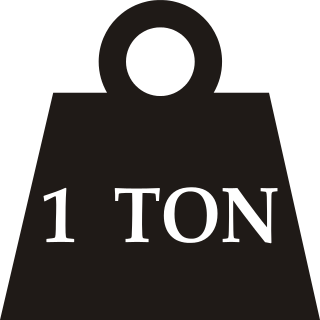
Ton is any of several units of measure of mass, volume or force. It has a long history and has acquired several meanings and uses.
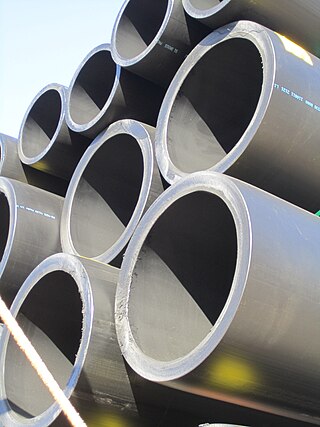
A slurry pipeline is a specially engineered pipeline used to move ores, such as coal or iron, or mining waste, called tailings, over long distances. A mixture of the ore concentrate and water, called slurry, is pumped to its destination and the water is filtered out. Due to the abrasive properties of slurry, the pipelines can be lined with high-density polyethylene (HDPE), or manufactured completely from HDPE Pipe, although this requires a very thick pipe wall. Slurry pipelines are used as an alternative to railroad transportation when mines are located in remote, inaccessible areas.

A pipeline is a system of pipes for long-distance transportation of a liquid or gas, typically to a market area for consumption. The latest data from 2014 gives a total of slightly less than 2,175,000 miles (3,500,000 km) of pipeline in 120 countries around the world. The United States had 65%, Russia had 8%, and Canada had 3%, thus 76% of all pipeline were in these three countries. The main attribute to pollution from pipelines is caused by corrosion and leakage

Drax power station is a large biomass power station in Drax, North Yorkshire, England, capable of co-firing petroleum coke. It has a 2.6 GW capacity for biomass and had a 1.29 GW capacity for coal that was retired in 2021. Its name comes from the nearby village of Drax. It is situated on the River Ouse between Selby and Goole. Its generating capacity of 3,906 megawatts (MW), which includes the shut down coal units, is the highest of any power station in the United Kingdom, providing about 6% of the United Kingdom's electricity supply.

A tender or coal-car is a special rail vehicle hauled by a steam locomotive containing its fuel and water. Steam locomotives consume large quantities of water compared to the quantity of fuel, so their tenders are necessary to keep them running over long distances. A locomotive that pulls a tender is called a tender locomotive. Locomotives that do not have tenders and carry all their fuel and water on board the locomotive itself are called tank locomotives or tank engines.
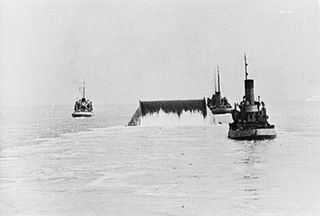
Operation Pluto was an operation by British engineers, oil companies and the British Armed Forces to build submarine oil pipelines under the English Channel to support Operation Overlord, the Allied invasion of Normandy during the Second World War.

Liquefied natural gas (LNG) is natural gas (predominantly methane, CH4, with some mixture of ethane, C2H6) that has been cooled down to liquid form for ease and safety of non-pressurized storage or transport. It takes up about 1/600th the volume of natural gas in the gaseous state at standard conditions for temperature and pressure.
The Fischer–Tropsch process (FT) is a collection of chemical reactions that converts a mixture of carbon monoxide and hydrogen, known as syngas, into liquid hydrocarbons. These reactions occur in the presence of metal catalysts, typically at temperatures of 150–300 °C (302–572 °F) and pressures of one to several tens of atmospheres. The Fischer–Tropsch process is an important reaction in both coal liquefaction and gas to liquids technology for producing liquid hydrocarbons.

A coal preparation plant is a facility that washes coal of soil and rock, crushes it into graded sized chunks (sorting), stockpiles grades preparing it for transport to market, and more often than not, also loads coal into rail cars, barges, or ships.

Plant Bowen, commonly known as Bowen Steam Plant, is a coal-fired power station located just outside Euharlee, Georgia, United States, approximately 8.7 mi (14 km) west-south-west from Cartersville. At over 3,450 megawatts, Plant Bowen is one of the largest coal-fired power plants in North America. The station is connected to the southeastern power grid by numerous 500 kV transmission lines, and is owned and operated by Georgia Power, a subsidiary of Southern Company.
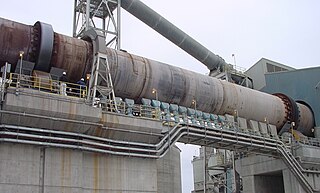
Cement kilns are used for the pyroprocessing stage of manufacture of portland and other types of hydraulic cement, in which calcium carbonate reacts with silica-bearing minerals to form a mixture of calcium silicates. Over a billion tonnes of cement are made per year, and cement kilns are the heart of this production process: their capacity usually defines the capacity of the cement plant. As the main energy-consuming and greenhouse-gas–emitting stage of cement manufacture, improvement of kiln efficiency has been the central concern of cement manufacturing technology. Emissions from cement kilns are a major source of greenhouse gas emissions, accounting for around 2.5% of non-natural carbon emissions worldwide.
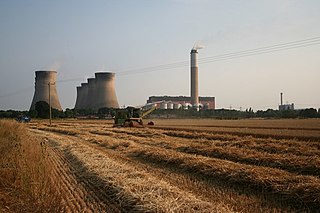
Cottam power station is a decommissioned coal-fired power station. The site extends over 620 acres (250 ha) of mainly arable land and is situated at the eastern edge of Nottinghamshire on the west bank of the River Trent at Cottam near Retford. The larger coal-fired station was decommissioned by EDF Energy in 2019 in line with the UK's goal to meet its zero-coal power generation by 2025. The smaller in-use station is Cottam Development Centre, a combined cycle gas turbine plant commissioned in 1999, with a generating capacity of 440 MW. This plant is owned by Uniper.

A coal-fired power station or coal power plant is a thermal power station which burns coal to generate electricity. Worldwide there are over 2,400 coal-fired power stations, totaling over 2,000 gigawatts capacity. They generate about a third of the world's electricity, but cause many illnesses and the most early deaths, mainly from air pollution.
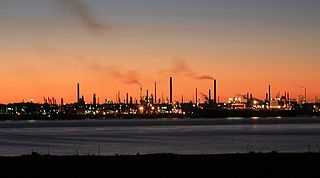
Fawley Refinery is an oil refinery located at Fawley, Hampshire, England. The refinery is owned by Esso Petroleum Company Limited, a subsidiary of Exxon Mobil Corporation, which acquired the site in 1925. Situated on Southampton Water, it was rebuilt and extended in 1951 and is now the largest oil refinery in the United Kingdom, and one of the most complex refineries in Europe. With a capacity of 270,000 barrels (43,000 m3) per day, Fawley provides 20 per cent of the UK's refinery capacity. Over 2,500 people are employed at the site.

Mohave Power Station was a 1580 megawatt electric (MWe) coal-fired power plant that was located in Laughlin, Nevada. Southern California Edison is the majority owner of the plant and was its operator. The plant entered commercial operation in 1971. A steam line that ran near the plant's control room and cafeteria ruptured on June 9, 1985, fatally scalding six and injuring ten more. In 2005, the plant was shut down and was later dismantled.
Coal slurry is a mixture of solids and liquids produced by a coal preparation plant.
Coal-water slurry fuel is a combustible mixture of fine coal particles suspended in water. It can be used to power boilers, gas turbines, diesel engines and heating and power stations.

Willington Power Station is a pair of partly demolished coal-fired power stations that were constructed in the 1950s. The two stations were built on a site off Twyford Road, between Willington and Twyford in Derbyshire, England. The two power stations had an installed capacity totaling 804 MW. The two stations consisted of the 'A' Station, and the 'B' Station.
Energy in Ethiopia includes energy and electricity production, consumption, transport, exportation, and importation in the country of Ethiopia.
High-density solids pumps are hydrostatically operating machines which displace the medium being pumped and thus create a flow.
References
- ↑ "Coal slurry pipelines relevance in India" . Retrieved 5 June 2013.
- ↑ "A technology assessment of coal slurry pipelines" (PDF). Retrieved 5 June 2015.
- ↑ "Long-distance transport of coal by Coal Log Pipeline" (PDF). Retrieved 5 June 2013.
- ↑ Hydraulic Transport of Coal in Combination With Oil Granulation / V.Biletsky // 8th International Conference on “Transport and Sedimentation of Solid Particles” 24–26 January 1995, Pragye, Czech Republic. D6-1 – D6-11.